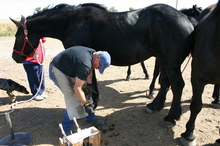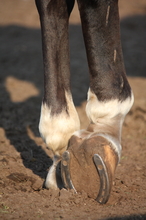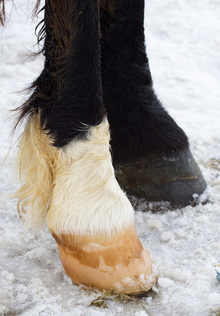
Should my horse be trimmed or should it be shod? This question should be asked of someone who has enough training and experience to give an accurate and practical answer.

Horse hoof care - A farrier at work
If we use our common sense (horse sense) we will see when horses need to be shod and when they only need to be trimmed. Every horse has different needs.
Horse owners would never knowingly harm their horses but unknowingly they may hurt a horse by an uninformed choice. Trimming or shoeing techniques must do no harm.
The horse should be more comfortable after being trimmed or shod. Horses were relied on heavily for centuries as the sole means of transportation and as work animals. If they had sore, short or injured feet they were of no value.
Some horses do not require shoeing. In our area, because of the soil and intermittent use, some horses can go without horseshoes. In the area where we used to live the soil was so abrasive horses needed shoes even when on pasture.
Each horse's situation must be evaluated individually. Here are several considerations regarding your horseâs hooves so you can determine whether they need to be shod or only trimmed.
Pros for trimming only â when shoes are not necessary
1. Hoof wall growth exceeds wear
The normal growth rate of a horse hoof is ¼ to 3/8 inches per month. The horse needs the hoof for protection of the sensitive structures and bone inside the foot. In cases where a horse does not wear down the hoof at the rate it grows and is maintained on a regular schedule, excess hoof needs to be trimmed off to maintain soundness.
2. The integrity of the hoof warrants a trim only
All hooves cannot be placed into one category. Domesticated horses are unlike wild horses except in genus and species. A hoof's integrity is mostly due to genetics but can be affected by environment and management. There are some feet that are very strong. Other feet are weak and require an alternative to just trimming.
3. The horse's conformation requires a trim only
A horse's individual conformation should be considered when thinking of trimming versus shoeing. A horse's conformation affects both hoof growth and wear.
Pros for shoeing when trimming only is not enough
1. Abrasion causes hoof wear to exceed growth.
As a horse is used over an abrasive surface the hooves wear more than the rate of growth not leaving enough protection. When the foot needs protection a horseshoe could be helpful.

When shoes are needed
The type of ground a horse works on may cause abrasion, wearing the hoof down faster than the growth can be replaced.
Horses that are used seasonally may require shoes. For example, horses used for trail rides may only need shoes during the riding season. Their use and the type of ground they are working on may cause abrasion, wearing the hoof down faster than the growth can be replaced.
These horses are shod only during the season of use and then horseshoes are pulled and hooves are trimmed for the winter.
2. The hoof and foot need protection
Horses may require foot protection which can be applied by a horseshoe and pad. Hoof boots have become popular in some areas for a temporary solution for foot protection. There are many reasons why a horse might need some type of protection. One example would be an abscess, that needs protection while it is healing.
3. Hoof integrity is compromised (weak feet)
When a horse has a nutrient deficiency, such as vitamin A, the hoof becomes weak. When the horse is exposed to a nutrient toxicity, such as selenium, the hoof's integrity is destroyed. This is variable depending on soil content and diet.
If a hoof's integrity has been compromised by nutrition or heredity, an additional modification to a horseshoe may be necessary such as clips to take stress off of the horseshoe nails and help hold the horseshoe on the weak foot. In extreme situations a horseshoe may need to be glued-on. Forcing a sore horse to go barefoot is cruel.
4. The horse's conformation requires skeletal support.
Horseshoes can be beneficial to support a horse's use. Conformation can be influenced with support in the right area. A fetlock varus (toed-in) conformation would benefit from a horseshoe fit wider on the outside. This redistributes weight around the legâs center of gravity taking stress off of the outside joints, making the horse more comfortable. Horseshoes can be helpful if a horse's conformation requires redistribution of weight under the foot and horse's limb center of gravity.
5. The horse requires increased traction.
When a horse is required to perform in some disciplines, traction for the safety of the horse and rider are considered. Hooves are influenced by the footing or surface they work on.

When the horse needs traction
In winter, a horse ridden outside may require extra traction for the safety of horse and rider.
A backyard horse's use cannot be measured the same as a performance horse's use. A horse may require more traction than a hoof can provide.
There are many types of manufactured and handmade horseshoes that are made for the benefit of increased traction.
In winter, a horse ridden outside may require extra traction for the safety of horse and rider. Horses used on pavement feel more confident with extra traction.
6. The horse requires decreased traction.
A reining horse can be helped with the aid of a wider web horseshoe that decreases traction. This enables a horse to perform what he has been bred and trained to do.
The wider horseshoe that is flat with only stamped nail holes allows the horse to slide longer, preventing the horse from sinking into the ground too fast.
Did you know?
A horse's hoof may look like a solid object, tough and hard all the way through, but that is not the case. The hoof is made up of several layers and structures, each with a specific function.
Summary
As you consider your own individual situation, these points can help you make an educated decision. If you still are not sure, ask a professional farrier. Some horse owners might choose trimming versus shoeing because it is the cheaper option. The questions and reasons for trimming versus shoeing have to be considered along with cost. Cost should not be the sole factor. The welfare of the horse should be paramount.
If we use our common sense (horse sense) we will see when horses need to be shod and when they only need to be trimmed. Every horse has different needs. Horses with good quality hooves that wear away at about the same rate they grow and are ridden in low abrasion environments, may never need shoeing. Modern selectively bred horses with weak feet may always need to be shod. All hooves need attention at least every two months. Problem and diseased feet may need monthly attention.
By Jacob Butler CJF, AWCF - Butler Professional Farrier School LLC For more information visit his website at www.butlerprofessionalfarrierschool.com or call (308)665-1510 or email jacob@dougbutler.com.
